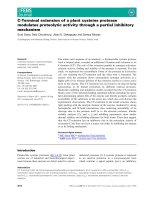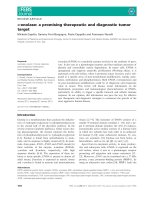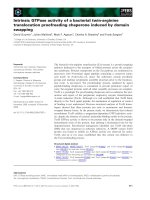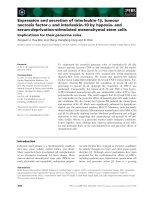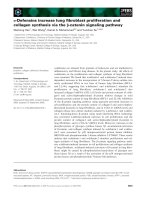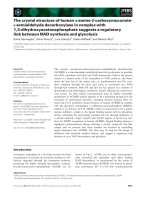Tài liệu Báo cáo khoa học: "A semantically-derived subset of English for hardware verification" pdf
Bạn đang xem bản rút gọn của tài liệu. Xem và tải ngay bản đầy đủ của tài liệu tại đây (544.33 KB, 6 trang )
A semantically-derived subset of English for hardware verification
Alexander Holt and Ewan Klein
HCRC Language Technology Group
Division of Informatics
University of Edinburgh
alexander, holt@ed, ac. uk ewan. kleinOed, ac. uk
Abstract
To verify hardware designs by model checking,
circuit specifications are commonly expressed in
the temporal logic CTL. Automatic conversion
of English to CTL requires the definition of an
appropriately restricted subset of English. We
show how the limited semantic expressibility of
CTL can be exploited to derive a hierarchy of
subsets. Our strategy avoids potential difficulties
with approaches that take existing computational
semantic analyses of English as their starting
point such as the need to ensure that all sentences
in the subset possess a CTL translation.
1 Specifications in Natural Language
Mechanised formal specification and verification
tools can significantly aid system design in both
software and hardware (Clarke and Wing, 1996).
One well-established approach to verification, par-
ticularly of hardware and protocols, is temporal
model checking, which allows the designer to
check 'that certain desired properties hold of the
system (Clarke and Emerson, 1981). In this
approach, specifications are expressed in a temporal
logic and systems are represented as finite state
transition systems? An efficient search method
determines whether the desired property is true in
the model provided by the transition system; if
not, it provides a counterexample. Despite the
undoubted success of temporal model checking as
a technique, the requirement that specifications be
expressed in temporal logic has proved an obstacle
to its take-up by circuit designers and therefore
alternative interfaces involving graphics and natural
language have been explored. In this paper, we
address some of the challenges raised by converting
l In practice,
it
turns out to be preferable to use a symbolic
representation of the state model, thereby avoiding the
state
explosion problem
(Macmillan, 1993).
English specifications into temporal logic as a
prelude to hardware verification.
One general approach to this kind of task exploits
existing results in the computational analysis of
natural language semantics, including contextual
phenomena such as anaphora and ellipsis, in order
to bridge the gap between informal specifications
in English and formal specifications in some target
formalism (Fuchs and Schwitter, 1996; Schwitter
and Fuchs, 1996; Pulman, 1996; Nelken and
Francez, 1996). English input sentences are initially
mapped into a general purpose semantic formalism
such as Discourse Representation Theory (Kamp
and Reyle, 1993) or the Core Language Engine's
quasi logical form (Alshawi, 1992) at which point
context dependencies are resolved. The output of
this stage then undergoes a further mapping into
the application-specific language which expresses
formal specifications. One system which departs
from this framework is presented by Fantechi et al.
(1994), whose grammar contains special purpose
rules for recognising constructions that map directly
into ACTL formulas, 2 and can trigger clarification
dialogues with the user in the case of a one-to-many
mapping.
Independently, the interface may require the user
to employ a controlled language, in which syntax
and lexicon are restricted in order to minimise
ambiguity with respect to the formal specification
language (Macias and Pulman, 1995; Fuchs and
Schwitter, 1996; Schwitter and Fuchs, 1996). The
design of a controlled language is one method
of addressing the key problem pointed out by
Pulman (1996, p. 235), namely to ensure that an
English input has a valid translation into the target
formalism; this is the problem that we focus on
here. Inevitably, we need to pay some attention to
2ACTL is an action-based branching temporal logic which,
despite the name, is not directly related to the CTL language
that we discuss below.
451
SO
v
2
SI
Figure 1: A CTL structure
the syntactic and semantic properties of our target
• formalism and this is the topic of the next section.
2 CTL Specification and Model Checking
While early attempts to use temporal logics for
verification had explored both linear and branching
models of time, Clarke et al. (1986) showed that
the branching temporal logic CTL (Computation
Tree Logic) allowed efficient model-checking in
place of laborious proof construction methods)
In models of CTL, the temporal order relation <
defines a tree which branches towards the future.
As pointed out by Thomason (1984), branching
time provides a basis for formalising the intuition
that statements of necessity and possibility are often
non-trivially tensed. As we move forward through
time, certain possible worlds (i.e., paths in the tree)
are eliminated, and thus what was possible at t is no
longer available as an option at some t' later than t.
CTL uses formulas beginning with A to express
necessity. AG f is true at a time t just in case f
is true along all paths that branch forward from the
tree at t (true globally). AFf holds when, on all
paths, f is true at some time in the future. AXf is
true at t when f is true at the next time point, along
all paths. Finally, A[f U g] holds if, for each path,
g is true at some time, and from now until that point
f is true.
Figure I, from Clarke et al. (1986), illustrates
a CTL model structure, with the relation <
represented by arrows between circles (states), and
the atomic propositions holding at a state being the
letters contained in the circle. A CTL structure gives
rise to an infinite computation tree, and Figure 2
3Subsequently, model-checking methods which use linear
temporal logic have been developed. While theoretically less
efficient that those based on CTL, they may turn out to be
effective in practice (Vardi, 1998).
/\
SI $2
t L
SO Sl
/\
1
Sl $2 SO
Figure 2: Computation tree
shows the initial part of such a tree corresponding
to Figure 1, when so is selected as the initial
state. States correspond to points of time in the
course of a computation, and branches represent
non-determinism. Formulas of CTL are either true
or false with respect to any given model; see Table 1
for three examples interpreted at So in the Figure 1
structure.
3 Data
One of our key tasks has been to collect an
initial sample of specifications in English, so as to
identify linguistic constructions and usages typical
of specification discourse. We currently have a
corpus of around a hundred sentences, most of
which were elicited by asking suitably qualified
respondents to describe the behaviour manifested by
timing diagrams. An example of such a diagram is
displayed in Figure 3, which is adapted from one of
Fisler's (1996, p. 5).
The horizontal axis of the diagram indicates the
passing of time (as measured by clock cycles) and
the vertical axis indicates the transition of signals
between the states of high and low. (A signal is
formula
AXc
AGb
AF(AX(a /x b) )
sense
for all paths, at the next
state c is true
for all paths, globally b
is true
for all paths, eventually
there is a state from
which, for all paths, at
the following state a
and b are true
at So
true
false
true
Table 1: Interpretation of CTL formulas
452
O
I
i
t
t :
=1
Figure 3: Timing diagram for pulsing circuit
r
/. .\
\ / .
\ / \
\
Figure 4: Timing diagram for handshaking protocol
a time-varying value present at some point in the
circuit.) In Figure 3, the input signal i makes a
transition from high to low which after a one-cycle
delay triggers a unit-duration pulse on the output
signal o.
(la-b) give two possible English descriptions of
the regularity illustrated by Figure 3,
(1) a. A pulse of width one is generated on the
output o one cycle after it detects a falling
edge on input i.
b. If i is high and then is low on the next
cycle, then o is low and after one cycle
becomes high and then after one more
cycle becomes low.
while (2) is a CTL description.
(2) AG(i + AX(",i + ( ,oAAX(oAAX-,o))))
A noteworthy difference between the two English
renderings is that the first is clearly more abstract
than the second. Description (lb) is closer to
the CTL formula (2), and consequently easier to
translate into CTL. 4
For another example of the same phenomenon,
consider the timing diagram in Figure 4. As
before, sentences (3a-b) give two possible English
descriptions of the regularity illustrated by Figure 4,
4Our system does not yet resolve anaphoric references, as
in (la). There are existing English-to-CTL systems which do,
however, such as that of Nelken and Francez (1996).
(3)
a. Every request is eventually acknowledged
and once a request is acknowledged the
request is eventually deasserted and
eventually after that the acknowledge
signal goes low.
b. If r rises then after one cycle eventually a
rises and then after one cycle eventually r
falls and then after one cycle eventually a
falls.
which can be rendered in CTL as (4).
(4) AG('-,r AAXr ~ AF(-,a AAX(a
AAF(r AAX( ,r AAF(a AAX ,a))))))
Example (3b) parallels (lb) in being closer to
CTL than its (a) counterpart. Nevertheless, (3b)
is ontologically richer than CTL in an important
respect, in that it makes reference to the event
predicates rise and fall.
4 Defining a Controlled Language
Even confining our attention to hardware speci-
fications of the level of complexity examined so
far, we can conclude there are some kinds of
English locutions which will map rather directly
into CTL, whereas others have a much less direct
relation. What is the nature of this indirect
relation? Our claim in this paper is that we can
give semantically-oriented characterisations of the
relation between complexity in English sentences
and their suitability for inclusion in a controlled
language for hardware verification. Moreover, this
semantic orientation yields a hierarchy of subsets
of English. (This hierarchy is a theoretical entity
constructed for our specific purposes, of course, not
a general linguistic hypothesis about English.)
Our first step in developing an English-to-CTL
conversion system was to build a prototype based
on the Alvey Natural Language Tools Grammar
(Grover et al., 1993). The Alvey grammar is a broad
coverage grammar of English using GPSG-style
rules, and maps into a event-based, unscoped
semantic representation.
For this application, we used a highly restricted
lexicon and simplified the grammar in a number
of ways (for example: fewer coordination rules;
no deontic readings of modals). Tidhar (1998)
reports an initial experiment in taking the semantic
output generated from a small set S of English
specifications, and converting it into CTL. Given
453
that the Alvey grammar will produce plausible
semantic readings for a much larger set S', the
challenge is to characterise an intermediate set S,
with S C S C S', that would admit a translation ~b
into formulas of CTL. Let's assume that we have a
reverse translation ~b -x from CTL to English; then
we would like S =
range(cP-x).
4.1 Transliteration
Now suppose that ~b -l is a
literal
translation from
CTL to English. That is, we recurse on the formulas
of CTL, choosing a canonical lexical item or phrase
in English as a direct counterpart to each constituent
of the CTL formula. In fact, we have implemented
such a translation as a DCG ct12eng. To illustrate,
ct12eng maps the formula (2) into (5):
(5) globally if i is high then after 1 cycle if i is
low then o is low and after 1 cycle o is high
and after 1 cycle o is low
Let cp~ -1 be the function defined by ct12eng;
then we call
El = range(~-(1)
the
canonical
transliteration
level of English. We can be confident
that it is possible to build a translation ~bl which
will map any sentence in El into a formula of
CTL. L t can be trivially augmented by adding
near-synonymous lexical and syntactic variants. For
example,
i is high
can be replaced by
signal i holds,
and
after 1 cycle
by
1 cycle later
This adds
no semantic complexity. We call the this language
(notated/2+) the
augmented transliteration
level.
One potential problem with defining q~t in this
way is that the sentences generated by ctl2eng
soon become structurally ambiguous. We can solve
this either by generating unambiguous paraphrases,
or by analysing the relevant class of ambiguities and
making sure that ~bt is able to provide all relevant
CTL interpretations.
These languages contain only sentences. Hard-
ware specifications often have the form of multi-
sentence discourses, however. Such discourses, and
the additional phenomena they introduce, occur at
higher levels of our language hierarchy, and we
presently lack any detailed analysis of them in the
terms of this paper.
4.2 Compositional indirect semantics
We'll say that an English input expression has
compositional indirect
semantics just in case
1. there is a compositional mapping to CTL, but
where
2. the semantics of the English is ontologically
richer than the intended CTL translation.
The best way to explain these notions is by way
of some examples. First, consider expressions like
the nouns
pulse, edge
and the verbs
rise, fall.
These
refer to certain kinds of event. For example, an
edge
denotes the event where a signal changes between
two distinct states; from high at time t to low at time
t + 1 or conversely. In CTL, the notion of an edge on
signal i corresponds approximately to the following
expression: 5
(6) (i A
AX~i) v (",i A AXi)
Similarly, a
pulse
can be analysed in terms of a
rising edge followed by a falling edge.
What do we mean by saying that there is a
compositional
mapping of locutions at this level to
CTL? Our claim is that they can be algorithmically
converted into pure CTL without reference to
unbounded context. What do we mean by saying
that these English expressions involve a richer
ontology than CTL? If compositional mapping
holds, then clearly we are not forced to augment the
standard models for CTL in order to interpret them
(although this route might be desirable for other
reasons). Rather, we are saying that the 'natural'
ontology for these expressions is richer than that
allowed for CTL, even if reduction is possible. 6
4.3 Non-compositional indirect semantics
We consider the conversion to involve
non-
compositional indirect semantics
when there is
some aspect of non-locality in the domain of the
translation function. That is, some form of inference
is required probably involving domain-specific
axioms or general temporal axioms in order to
obtain a CTL formula from the English expression.
Here are two examples. The first comes from
sentence (3a), where the use of
eventually
might
normally be taken to correspond directly to the CTL
operator
AF.
However because of the domain of
(3a) a handshaking protocol, evidenced by the use
of the verbs
acknowledge
and
request it
is in fact
more accurate to require an extra
AX
in the CTL.
5Approximately, in the sense that one cannot simply
substitute this expression arbitrarily into a larger formula, as
it depends on the syntactic context for example, whether it
occurs in the antecedent or consequent of an implication.
6There is a further kind of ontological richness in English at
this level, involving the
relation
between events, rather than the
events themselves. Space prohibits a closer examination here.
454
level
/21
expressiveness
pure CTL
examples
i is high; after 1 cycle
pure CTL i holds; 1 cycle later
/22 extended CTL i rises; there is a pulse
of unit duration
/23 full SR?
r
is eventually
acknowledged
Table 2: Language hierarchy
This ensures that the three transitions cannot occur
at the same time.
We see here an example of domain-specific
interpretation conventions that our system needs to
be aware of. Clearly, it must incorporate them
in such a way that users are still able to reliably
predict how the system will react to their English
specifications.
The second example is
(7) From one cycle after i changes until it changes
again x and y are different.
In this case there is an interaction between a
non-local linguistic phenomenon and something
specific to the CTL conversion, namely how to
make the right connection between the first and the
second changes.
4.4 Language hierarchy
Table 2 summarises the main proposals of this
section. The left-hand column lists the hierarchy
of postulated sublanguages, in increasing order of
semantic expressiveness. The middle column tries
to calibrate this expressiveness. By 'extended CTL',
we mean a superset of CTL which is syntactically
augmented to allow formulas such as rise(p),
fall(p), discussed earlier, and pulse(p, v, n), where
p is an atom, v is a Boolean indicating a high or
low value, and n is a natural number indicating
duration. The semantic clauses would have to
be correspondingly augmented as carried out for
example by Nelken and Francez (1996), for rise(p)
and fall(p). By 'full SR', we are hypothesising that
it would be necessary to invoke a general semantic
representation language for English.
We have constructed a context-free grammar for
/22, in order to obtain a concrete approximation to
a controlled subset of English for expressing spec-
ifications. There are two cautionary observations.
First, as just indicated, /22 maps directly not into
CTL, but into extended CTL. Second, our grammar
for/22 ignores some subtleties of English syntax and
morphology. For example, subject-verb agreement;
modal auxiliary subcategorisation; varieties of verb
phrase modification by adverbs; and forms of
anaphora.
These defects in our CFG for /22 are not
fundamental problems, however. The device of
using the ct12eng mapping to define a sublanguage
is a specific methodology for finding a semantically
motivated sublanguage. As such it is only an
approximation to the language that we wish our
system to deal with. This CFG is not the
grammar used by our parser (which can, in fact,
deal with many of the details of English syntax
just mentioned). We may, therefore, introduce a
language/2+ which corrects the grammatical errors
of 122 and extends it with some degree of anaphora
and ellipsis.
We note that it would be useful to have a
firmer theoretical grasp on the relations between our
sublanguages; we have ongoing work in this area.
5 Conclusion
Much work on controlled languages has been
motivated by the ambition to "find the fight trade-
off between expressiveness and processability"
(Schwitter and Fuchs, 1996). An alternative,
suggested by what we have proposed here, is to
bring into play a hierarchy of controlled languages,
ordered by the degree to which they semantically
approximate the target formalism. Each point in
the hierarchy brings different trade-offs between
expressiveness and tractability, and evaluating their
different merits will depend heavily on the particu-
lar task within a generic application domain, as well
as on the class of users.
As a final remark, we wish to point out that
there may be advantages in identifying plausible
restrictions on the target formalism. Dwyer et
al. (1998a; 1998b) have convincingly argued that
users of formal verification languages make use
of recurring specification patterns. That is, rather
than drawing on the full complexity of languages
such as CTL, documented specifications tend to
fall into much simpler formulations which express
commonly desired properties. In future work, we
plan to investigate specification patterns as a further
source of constraints that propagate backwards into
the controlled English, perhaps providing additional
mechanisms for dealing with apparent ambiguity in
user input.
455
Acknowledgements
The work reported here has been carried out as part
of PROSPER (Proof and Specification Assisted De-
sign Environments), ESPRIT Framework IV LTR
26241,
Thanks to Marc Moens, Claire Grover, Mike
Fourman, Dirk Hoffman, Tom Melham, Thomas
Kropf, Mike Gordon, and our ACL reviewers.
References
Hiyan Alshawi, editor. 1992.
The Core Language
Engine.
MIT Press.
Edmund M. Clarke and E. Allen Emerson.
1981. Synthesis of synchronization skeletons
for branching time temporal logic. In
Logic of
Programs: Workshop, Yorktown Heights, NY,
May 1981,
volume 131 of
Lecture Notes in
Computer Science.
Springer-Verlag.
Edmund M. Clarke and Jeanette M. Wing. 1996.
Formal methods: State of the art and future direc-
tions.
ACM Computing Surveys,
28(4):626-643.
Edmund M. Clarke, E. Allen Emerson, and
A. Prasad Sistla. 1986. Automatic verification
of finite-state concurrent systems using tempo-
ral logic specifications.
ACM Transactions on
Programming Languages and Systems,
8(2):244-
263.
Matthew B. Dwyer, George S. Avrunin, and
James C. Corbett. 1998a. Patterns in property
specifications for finite-state verification. Tech-
nical Report KSU CIS TR-98-9, Department of
Computing and Information Sciences, Kansas
State University.
Matthew B. Dwyer, George S. Avrunin, and
James C. Corbett. 1998b. Property specification
patterns for finite-state verification. In M. Ardis,
editor,
Proceedings of the Second Workshop on
Formal Methods in Software Practice,
pages
7-15.
A. Fantechi, S. Gnesi, G. Ristori, M. Carenini,
M. Marino, and P. Moreschini. 1994. Assisting
requirement formalization by means of natural
language translation.
Formal Methods in System
Design,
4:243-263.
Kathryn Fisler. 1996.
A Unified Approach to Hard-
ware Verification through a Heterogeneous Logic
of Design Diagrams.
Ph.D. thesis, Department of
Computer Science, Indiana University.
Norbert E. Fuchs and Rolf Schwitter. 1996.
Attempto Controlled English (ACE). In
CLAW
96: First International Workshop on Controlled
Language Applications.
Centre for Computa-
tional Linguistics, Katholieke Universiteit Leu-
ven, Belgium.
Claire Grover, John Carroll, and Ted Briscoe. 1993.
The Alvey Natural Language Tools Grammar
(4th release). Technical Report 284, Computer
Laboratory, University of Cambridge.
Hans Kamp and Uwe Reyle. 1993.
From Discourse
to Logic: Introduction to Modeltheoretic Se-
mantics of Natural Language, Formal Logic and
Discourse Representation Theory.
Number 42 in
Studies in Linguistics and Philosophy. Kluwer.
Benjamin Macias and Stephen G. Pulman. 1995.
A method for controlling the production of
specifications in natural language.
The Computer
Journal,
38(4):310-318.
Kenneth L. Macmillan. 1993.
Symbolic Model
Checking.
Kluwer.
Rani Nelken and Nissim Francez. 1996. Translat-
ing natural language system specifications into
temporal logic via DRT. Technical Report LCL-
96-2, Laboratory for Computational Linguistics,
Technion, Israel Institute of Technology.
Stephen G. Pulman. 1996. Controlled language
for knowledge representation. In
CLAW 96:
Proceedings of the First International Workshop
on Controlled Language Applications,
pages
233-242. Centre for Computational Linguistics,
Katholieke Universiteit Leuven, Belgium.
Rolf Schwitter and Norbert E. Fuchs. 1996.
Attempto from specifications in controlled
natural language towards executable specifica-
tions. In
GI EMISA Workshop.
Nattirlichsprach-
licher Entwurf von Informations-systemen, Tutz-
ing, Germany.
Richmond H. Thomason. 1984. Combinations
of tense and modality. In D. Gabbay and
E Guenthner, editors,
Handbook of Philosophical
Logic. Volume II: Extensions of Classical Logic,
volume 146 of
Synthese Library,
chapter 11.3,
pages 89-134. D. Reidel.
Dan Tidhar. 1998. ALVEY to CTL translation
A preparatory study for finite-state verification
natural language interface. Msc dissertation, De-
partment of Linguistics, University of Edinburgh.
Moshe Y. Vardi. 1998. Linear vs. branching time:
A complexity-theoretic perspective. In
LICS'98:
Proceedings of the Annual IEEE Symposium on
Logic in Computer Science.
Indiana University.
456
